- Submissions

Full Text
Researches in Arthritis & Bone Study
Knee Dislocation and Patellar Tendon Disruption: A Case Report
Rodrigo KP* and Wallace MP
Department of Orthopedics and Traumatology, Brazil
*Corresponding author:Rodrigo KP, Department of Orthopedics and Traumatology, Campo Grande (MS), Brazil
Submission: May 1, 2019;Published: May 14, 2019

Volume1 Issue4 May 2019
Abstract
Dislocation of the knee is a serious event, often caused by a violent trauma. Patellar tendon rupture cases are described in patients with trauma and even with no trauma at all in some chronic systemic diseases. This is a case report of these two events together in the same patient. A 56 years-old man with rheumatoid arthritis had knee dislocation and patellar tendon disruption after a small trauma. Due to local cellulitis, the surgery was postponed. We decided to perform reconstruction of the patellar tendon only because of the patient’s comorbidity and because the knee was stable. The patient resumed his job after six months of physical therapy. In this report, we describe a very uncommon case of knee dislocation and patellar tendon disruption together. Although the surgery is currently the choice to treat knee dislocation, this patient had only the patellar tendon reconstruction due the rheumatoid arthritis. This very uncommon case, with a surgery treatment, reminds us to be always careful when examining a patient with knee dislocation. We should not forget to examine the patellar height.Keywords: Aquatic exercise; Arthritis; Osteoarthritis
Keywords: Knee dislocation; Tendons; Tendon injuries arthritis; Rheumatoid
Introduction
Dislocation of the knee is a serious event, often caused by a violent trauma [1,2]. Concomitant soft tissue injuries and ligaments can occur and should also be considered vascular injuries. The patellar tendon injury is one example. Patellar tendon rupture cases are described in patients with chronic systemic diseases, such as rheumatoid arthritis, gout and lupus [3] with small traumas or even with no trauma at all. The steroids used to treat the diseases are implicated in the damage to the tendon. The literature describes some cases of knee dislocation and of patellar tendon disruption, separately. Of our knowledge, knee dislocation and patellar tendon injury, together, was described in only one article [4]. We describe here a very uncommon case of knee dislocation and disruption of the patellar tendon due to a non-violent trauma in a 56 years-old man with rheumatoid arthritis.
Case Report
A 56 years-old laborer with rheumatoid arthritis had a small accident in the work site, when he stepped in a hole. He had knee dislocation and a patellar tendon disruption. He was attended at the urgency in a hospital close to the work site, and he reported being punctured and immobilized with a plaster splint. The knee had already reduced spontaneously when cast was applied. He was transferred to our service two days after the accident, with radiographs showing the patella alta and no associated fractures or vascular injuries (Figures 1 & 2).
Figure 1:

Figure 2:
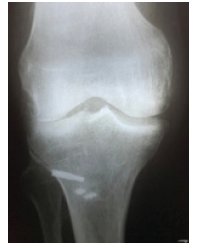
His case was reviewed and a Magnetic Resonance Imaging (MRI) exam showed injury of the Anterior Cruciate Ligament (ACL), Posterior Cruciate Ligament (PCL), the Medial Collateral Ligament (MCL) and Lateral Collateral Ligament (LCL), besides the patellar tendon disruption (Figures 3-5). During hospitalization, he developed local knee cellulitis that was treated with intravenous Ciprofloxacin for 14 days, after a positive culture for Staphylococcus aureus. In the period of recovery from infection, he was submitted to therapy to reduce edema and pain, and the knee became stable.
Figure 3:
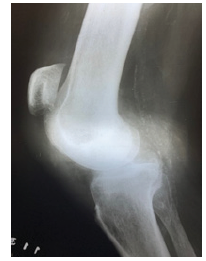
Figure 4:

Figure 5:
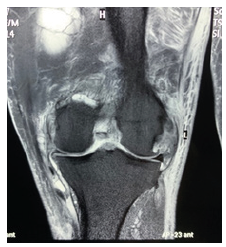
When laboratory tests results were normal, reconstruction of the patellar tendon was planned. Before surgery, the knee was stable, full passive range of motion was achieved, but the knee extensor mechanism was not functional. Surgeons chose, for the patellar tendon, the semi tendinosis tendon as graft, and used staples and anchors for fixation, taking into consideration the height of the patella, patellar rotation and path for the most correct fixation possible. The patient was discharged after two days. After six weeks using an immobilizer in full extension and without charge, he started physical therapy.
Figure 6:
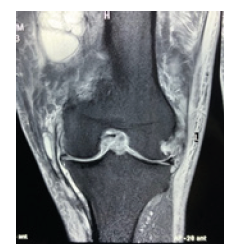
Figure 7:

Figure 8:
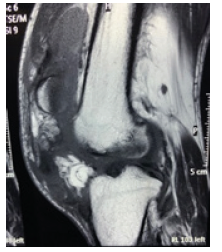
The patient remained in therapy for five months, when he was discharged with total active extension of the knee. Patellar height index evaluated in the radiographs was 1.08, by Caton-Deschamps index, and of 1.0 in the contralateral knee (Figures 6-8). The patient answered subjective evaluation questionnaires eight months and two years after surgery, which indicated increased KOOS (Knee Injury and Osteoarthritis Outcome Score), from 80.0 to 84.6; International Knee Documentation Committee (IKDC), from 80.5 to 93.3, and Western Ontario and McMaster Universities Arthritis Index (WOMAC), from 89.5 to 96. He was then able to resume the same work prior to surgery.
Discussion
Figure 9:

Knee dislocation is a severe soft tissue injury after a high-energy trauma. Knee dislocation itself is an unusual event in orthopedics [5]. We have reported a very unusual case of knee dislocation and patellar tendon injury in the same patient. The problem was probably caused by a posterior dislocation of the knee in a patient with rheumatoid arthritis. We found in the literature just a few cases of knee dislocation and others of patellar tendon disruption, however only one article reported these events together [4]. Some factors can cause tendon weakening, making it more susceptible to disruptions in mild trauma or even spontaneously. Advanced age causes a decrease in tissue perfusion and degenerative diseases can change collagen tissues (Figures 8-10).
Figure 10:

Lupus erythematosus and the use of local infiltration with steroids also predispose tendon ruptures. Indeed, a few cases have been reported concerning bilateral lesion of the patellar tendon in patients with systemic diseases [3,4,6,7]. Knee dislocation is classified currently in relation to the position of the tibia on the femur [5]. In this case report, the patient had probably a posterior dislocation, however it does not fit into any existing classification because he also had, simultaneously, patellar tendon injury. There are few reported cases of dislocation of the knee and, therefore, few studies on its treatment. The surgical approaches vary and are controversial. Some authors are in favor of conservative treatment [8,9]. However, surgery seems to be a good choice [10,11].
In our case, the repair was delayed due to cellulitis, and surgeons chose for a reconstruction using a graft, due to the framework of the infection. The decision to reconstruct the patellar tendon only was because he was a 56-years old patient with rheumatoid arthritis and a stable knee, with full passive range of motion prior to surgery. This very uncommon case, with a surgery treatment, reminds us to be always careful when examining a patient with knee dislocation. We should not forget to examine the patellar height.
Consent
Written, informed consent was obtained from the patient for publication of this case report and any accompanying images.
References
- Jiang W, Yao J, He Y, Sun W, Huang Y, et al. (2014) The timing of surgical treatment of knee dislocations: A systematic review. Knee Surg Sports Traumatol Arthrosc 23(10): 3108-3113.
- Kohl S, Stock A, Ahmad SS, Zumstein M, Keel M, et al. (2015) Dynamic intrafilamentary stabilization and primary repair: A new concept for the treatment of knee dislocation. Injury 46(4): 724-728.
- Kellersmann R, Blattert TR, Weckbach A (2005) Bilateral patellar tendon rupture without predisposing systemic disease or steroid use: A case report and review of the literature. Arch Orthop Trauma Surg 125(2): 127‐133.
- Ozkan C, Kalaci A, Tan I, Sarpel Y (2006) Bilateral dislocation of the knee with rupture of both patellar tendons. A case report. Knee 13(4): 333‐336.
- Kennedy JC (1963) Complete dislocation of the knee joint. J Bone Joint Surg Am 45: 889-904.
- Kuo RS, Sonnabend DH (1993) Simultaneous rupture of the patellar tendons bilaterally: Case report and review of the literature. J Trauma 34(3): 458‐460.
- Kamali M (1979) Bilateral traumatic rupture of the infrapatellar tendon. Clin Orthop Relat Res 142: 131‐134.
- Taylor AR, Arden GP, Rainey HA (1972) Traumatic dislocation of the knee. A report of forty‐three cases with special reference to conservative treatment. J Bone Joint Surg Br 54(1): 96‐102.
- Thomsen PB, Rud B, Jensen UH (1984) Stability and motion after traumatic dislocation of the knee. Acta Orthop Scand 55(3): 278‐283.
- Richter M, Bosch U, Wippermann B, Hofmann A, Krettek C (2002) Comparison of surgical repair or reconstruction of the cruciate ligaments versus nonsurgical treatment in patients with traumatic knee dislocations. Am J Sports Med 30(5): 718‐727.
- Liow RY, Mc Nicholas MJ, Keating JF, Nutton RW (2003) Ligament repair and reconstruction in traumatic dislocation of the knee. J Bone Joint Surg Br 85(6): 845‐851.
© 2019 Rodrigo KP. This is an open access article distributed under the terms of the Creative Commons Attribution License , which permits unrestricted use, distribution, and build upon your work non-commercially.
 a Creative Commons Attribution 4.0 International License. Based on a work at www.crimsonpublishers.com.
Best viewed in
a Creative Commons Attribution 4.0 International License. Based on a work at www.crimsonpublishers.com.
Best viewed in 







.jpg)






























 Editorial Board Registrations
Editorial Board Registrations Submit your Article
Submit your Article Refer a Friend
Refer a Friend Advertise With Us
Advertise With Us
.jpg)






.jpg)














.bmp)
.jpg)
.png)
.jpg)










.jpg)






.png)

.png)



.png)






